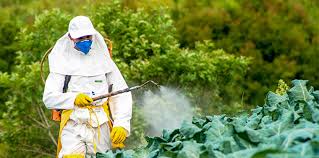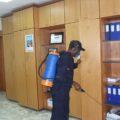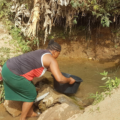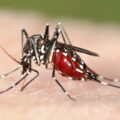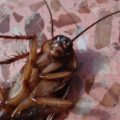Pesticides are chemical compounds that are used to kill pests, including insects, rodents, fungi and unwanted plants (weeds). Pesticides are used in public health to kill vectors of disease, such as mosquitoes, and in agriculture, to kill pests that damage crops. By their nature, pesticides are potentially toxic to other organisms, including humans, and need to be used safely and disposed of properly.
Types of Pesticides
There are many different types of pesticides, each is meant to be effective against specific pests. The term “-cide” comes from the Latin word “to kill.” The types of pesticides are:
Algaecides: are used for killing and/or slowing the growth of algae.
Biopesticides: are made of living things, come from living things, or they are found in nature.
Desiccants: are used to dry up living plant tissues.
Defoliants: cause plants to drop their leaves.
Disinfectants: control germs and microbes such as bacteria and viruses.
Foggers (total release foggers): are used to kill insects that are in the open and touch the pesticides.
Fungicides: are used to control fungal problems like molds, mildew, and rust.
Herbicides: kill or inhibit the growth of unwanted plants, aka weeds.
Miticides: control mites that feed on plants and animals. Mites are not insects, exactly.
Molluscicides: are designed to control slugs, snails and other molluscs.
Mothballs: are insecticides used to kill fabric pests by fumigation in sealed containers.
Ovicides: are used to control eggs of insects and mites.
Rodenticides: are used to kills rodents like mice, rats, and gophers.
|
Insecticide Types and Their Modes of Action |
|
| Insecticide Type |
Mode of Action |
| Organochlorine | Most act on neurons by causing a sodium/potassium imbalance preventing normal transmission of nerve impulses. Some act on the GABA (γ-aminobutyric acid) receptor preventing chloride ions from entering the neurons causing a hyperexcitable state characterized by tremors and convulsions. Usually broad-spectrum insecticides that have been taken out of use. |
| Organophosphate | Cause acetylcholinesterase (AChE) inhibition and accumulation of acetylcholine at neuromuscular junctions causing rapid twitching of voluntary muscles and eventually paralysis. A broad-range insecticide, generally the most toxic of all pesticides to vertebrates. |
| Organosulfur | Exhibit ovicidal activity (i.e., they kill the egg stage). Used only against mites with very low toxicity to other organisms. |
| Carbamates | Cause acetylcholinesterase (AChE) inhibition leading to central nervous system effects (i.e., rapid twitching of voluntary muscles and eventually paralysis). Has very broad spectrum toxicity and is highly toxic to fish. |
| Formamidines | Inhibit the enzyme monoamine oxidase that degrades neurotransmitters causing an accumulation of these compounds; affected insects become quiescent and die. Used in the control of OP and carbamate-resistant pests. |
| Dinitrophenols | Act by uncoupling or inhibiting oxidative phosphorylation preventing the formation of adenosine triphosphate (ATP). All types have been withdrawn from use. |
| Organotins | Inhibit phosphorylation at the site of dinitrophenol uncoupling, preventing the formation of ATP. Used extensively against mites on fruit trees and formerly used as an antifouling agent and molluscacide; very toxic to aquatic life. |
| Pyrethroids | Acts by keeping open the sodium channels in neuronal membranes affecting both the peripheral and central nervous systems causing a hyper-excitable state. Symptoms include tremors, incoordination, hyperactivity and paralysis. Effective against most agricultural insect pests; extremely toxic to fish. |
| Nicotinoids | Act on the central nervous system causing irreversible blockage of the postsynaptic nicotinergic acetylcholine receptors. Used in the control of sucking insects, soil insects, whiteflies, termites, turf insects and the Colorado potato beetle. Generally have low toxicity to mammals, birds and fish. |
| Spinosyns | Acts by disrupting binding of acetylcholine in nicotinic acetylcholine receptors at the postsynaptic cell. Effective against caterpillars, lepidopteran larvae, leaf miners, thrips and termites. Regarded for its high level of specificity. |
| Pyrazoles | Inhibits mitochondrial electron transport at the NADH-CoQ reductase site leading to disruption of ATP formation. Effective against psylla, aphids, whitefly and thrips. Results of testing on one type (fipronil) indicate no effects on the clams, oysters or fish, with marginal effects on shrimp. |
| Pyridazinones | Interrupt mitochondrial electron transport at Site 1; mainly used as a miticide; display toxicity to aquatic arthropods and fish. |
| Quinazolines | Acts on the larval stages of most insect by inhibiting or blocking the synthesis of chitin in the exoskeleton. Developing larvae exhibit rupture of the malformed cuticle or death by starvation; not registered in U.S. |
| Botanicals | Depending upon the type can have various effects: Pyrethrum – affects both the central and peripheral nervous systems, stimulating nerve cells to produce repetitive discharges and eventually leading to paralysis. Commonly used to control lice. Nicotine – mimics acetylcholine (Ach) in the central nervous system ganglia, causing twitching, convulsions and death. Used most to control aphids and caterpillars. Rotenone – acts as a respiratory enzyme inhibitor. Used as a piscicide that kills all fish at doses non-toxic to fish food organisms. Limonene – affects the sensory nerves of the peripheral nervous system. Used to control fleas, lice, mites and ticks, while remaining virtually non-toxic to warm-blooded animals and only slightly toxic to fish. Neem – reduces feeding and disrupts molting by inhibiting biosynthesis or metabolism of ecdysone, the juvenile molting hormone. Commonly used against moth and butterfly larvae. |
| Synergists/Activators | Inhibit cytochrome P-450 dependent polysubstrate monooxygenases (PSMOs) preventing the degradation of toxicants, enhancing the activity of insecticides when used in concert; synergists and activators are not in themselves considered toxic or insecticidal. |
| Antibiotics | Act by blocking the neurotransmitter GABA at the neuromuscular junction; feeding and egg laying stop shortly after exposure while death may take several days. Most promising use of these materials is the control of spider mites, leafminers and other difficult to control greenhouse pests. |
| Fumigants | Act as narcotics that lodge in lipid-containing tissues inducing narcosis, sleep or unconsciousness; pest affected depends on particular compound. |
| Inorganics | Mode of action is dependent upon type of inorganic: may uncouple oxidative phosphorylation (arsenicals), inhibit enzymes involved in energy production, or act as desiccants. Pest group depends on compound (e.g., sulfur for mites, boric acid for cockroaches). |
| Biorational | Grouped as biochemicals (hormones, enzymes, pheromones natural agents such as growth regulators) or microbials (viruses, bacteria, fungi, protozoa and nematodes). Act as either attractants, growth regulators or endotoxins; known for very low toxicity to non-target species. |
| Benzoylureas | Act as insect growth regulators by interfering with chitin synthesis. Greatest value is in the control of caterpillars and beetle larvae but is also registered for gypsy moth and mushroom fly. Some types are known for their impacts on invertebrates (reduced emergent species) and early life stages of sunfish (reduced weight) (Boyle et al. 1996). |
| From Radcliffe et al. (2009). | |
Choose the Right Pesticide
■ Choose the lowest toxicity pesticide that can be used legally on the target area, crop or plant and that will control the pest safely and effectively.
■ Plan ahead and buy no more pesticide than you need.
■ Keep pesticides separate from other items in a shopping cart and make sure they are wrapped in a separate bag at the checkout stand.
■ Transport pesticides in the trunk of the car instead of the backseat to avoid contaminating the car interior in case of breakage.
■ Make sure you have the proper safety and application equipment available and know how to use it.
Read and Follow the Label Directions
■ As a pesticide applicator, you are legally responsible for reading, understanding and following the label directions. Pesticide labels usually will contain the following sections:
■ Product name: This indicates the type of pesticide or what types of pests it will control.
■ U.S. EPA registration number: Make certain the product you purchase has a number. This is your assurance that the product has been reviewed properly and approved for use according to label instructions.
■ Ingredient statement: It lists the amount of each active ingredient and the total amount of inert ingredients.
■ Signal word: This indicates the toxicity of the product.
Products labeled “DANGER POISON” and accompanied by a skull and crossbones symbol are highly toxic.
Products labeled “DANGER” without the word “POISON” or the skull and crossbones symbol can cause severe skin injury or irreversible eye damage.
Products labeled “WARNING” are moderately toxic or may cause moderate eye or skin irritation.
Products labeled “CAUTION” are slightly toxic or may cause slight eye or skin irritation.
■ Precautionary statements: These warn about potential hazards to humans, domestic animals and the environment. They also indicate special fire, explosion or chemical hazards and methods to avoid or minimize risks.
■ First aid or statement of practical treatment: This indicates antidote or first aid treatment to administer.
■ KEEP OUT OF REACH OF CHILDREN: Pesticides always must be stored and kept out of reach of children.
■ Directions for use: They warn that federal law requires the pesticide to be used according to label directions. They indicate location, amount, frequency, and method and timing of the application. The label also indicates when people can re-enter the treated area safely to harvest the fruits or vegetables. Do not exceed the limits found on the label.
■ Other information on the label includes the name and address of the manufacturer and storage and disposal information.
Pesticide Exposure
Personal Protective Equipment: Personal protective equipment (PPE) MinPPE is clothing and other equipment worn to protect the body from contact with pesticides or pesticide residues. Pesticides can enter the body through inhalation, ingestion, or absorption by the skin and eyes. The skin usually receives the most exposure, so it is important to cover as much of the body as possible. Make sure you wear the required protective clothing (printed on the label) before opening the pesticide container. Wear the items of protective clothing the label requires: for example, long-sleeved shirts, long pants, overalls, nonabsorbent gloves (not leather or fabric), rubber footwear (not canvas or leather), a hat, goggles, or a dust mist filter. If no specific clothing is listed, non-absorbent gloves, long-sleeved shirts, long pants, socks, and closed shoes are recommended. Contact lenses may trap materials on the eyes; wear eye protection or remove contact lenses before mixing and applying pesticides.
When Mixing or Applying a Pesticide
- Never smoke or eat while mixing or applying pesticides. You could easily carry traces of the pesticide from your hands to your mouth. Also, some pesticide products are flammable.
- Follow the “Directions for Use” on the label carefully.
- Use only for the purpose listed.
- Use only the amount directed, at the time and under the conditions specified.
- Twice the amount will NOT do twice the job. You could harm yourself, others, or the plant/area/pet you are trying to protect.
- Always mix or dilute the pesticide outdoors or in a well-ventilated area. Only use the amount listed on the label and measure the pesticide carefully. (Never use the same measuring cups or spoons that you use in the kitchen.)
- Mix only the amount that you need for each application. Do not prepare larger amounts to store for possible future use. The pesticide will degrade and become ineffective over time. (See “Calculating the Correct Amount To Use”).
- Keep children, pets (including birds and fish), and toys (including pet toys) away from areas where you mix and apply pesticides for at least the length of time required on the label. If no time is listed on the label, wait until the pesticide has dried before reentering the area.
- If clothing becomes saturated in spray solution or contaminated with the pesticide concentrate, dispose of it immediately. Wash any parts of the body that may have been exposed to the pesticide, with soap and water, and finish the job in fresh, clean clothing.
- Bait Station Indoors or outdoors, never put bait for insects or rats, mice, and other rodents where small children or pets can reach it. Pesticides that are formulated as baits (containing a feed attractant) are still pesticides.
- Consider selective insecticides, with a limited range of target pests, to avoid harm to non-target organisms.
Storage
- Never put pesticides into food containers, such as empty soft drink or milk bottles. Keep pesticides in their original containers – ones that clearly identify the contents. Refasten all childproof caps tightly.
- If a spill occurs, clean it up promptly. Don’t wash it away. Instead, sprinkle the spill with sawdust, vermiculite, or kitty litter. Sweep it into a plastic garbage bag, and dispose of it as directed on the pesticide product label. Cleanup materials that are contaminated with a pesticide must be handled as pesticide waste.
Indoor Applications
- Make sure that the pesticide label indicates that the product can be used indoors. Never use pesticides labeled “for outdoor use only” inside a building.
- Provide adequate ventilation. If the label directions permit, leave all windows open and fans operating after the application is completed. If the pesticide product is only effective in an unventilated (sealed) room or house, do not stay there. Put all pets outdoors, and take yourself and your family away from treated areas for at least the length of time prescribed on the label.
- Apply most surface sprays only to limited areas such as cracks; don’t treat entire floors, walls, or ceilings unless the label recommends this use.
When using total release foggers to control pests, the most important precautions you can take are:
- use no more than the amount needed and
- keep foggers away from ignition sources (ovens, stoves, air conditioners, space heaters, water heaters, etc.).
- Do not place foggers in small, enclosed places such as closets and cabinets or under tables and counters.
In the Kitchen
- Remove food, pots and pans, and dishes before treating kitchen cabinet
- Don’t let pesticides get on any surfaces that are used for food preparation.
- Wait until shelves dry before refilling them.
- Wash any surfaces that may have pesticide residues before placing food on them.
- Cover aquariums with plastic during pesticide applications.
READ: Why Sniper Insecticide is Not Safe
Outdoor Applications
Drift is the movement of pesticides away from the target area or plants. You should always follow all label directions for both the pesticide and application equipment to prevent drift. Also:
- Never apply pesticides outdoors on a windy day (sustained winds higher than 8 mph) or when winds are gusty or variable in direction.
- Use coarse droplet nozzles on your sprayer to reduce misting. Larger droplets help prevent drift.
- Spray as close to the target as possible, you want to get good coverage, while still preventing drift
- Do not apply pesticides on very hot days, with temperatures above 90°F. The active ingredients in some pesticides can vaporize and drift onto non-target surfaces.
Do not over apply pesticides.
Excessive application could cause the pesticide to run off or seep into water supplies and contaminate them. Once contaminated it is difficult or impossible to clean water sources.
Excess spray may leave harmful residues on your homegrown fruit and vegetables, This could affect other plants, wildlife, and fish.
Read the label to determine if the pesticide should be watered-in by irrigation
Never mix or apply a pesticide near wellheads, stormwater drains, or bodies of water, such as creeks and streams.
Keep pesticides away from plants and wildlife you do not want to treat.
Some pesticides are toxic to pollinators, so read the label carefully to determine if there are application timing or other restrictions. A detailed brochure on pollinator protection can be downloaded from the Coalition for Urban Rural Environmental Stewardship (CURES).
Do not spray bird nests when treating trees.
Cove outdoor ornamental fishponds (do not allow to overheat).
When applying pesticides to food crops and gardens, always check to make sure they are labeled and follow the reentry time and time-to-harvest waiting period on the label. This varies by pesticide and crop.
After Applying a Pesticide, Indoors or Outdoors
- Proper cleaning procedures should always be followed after applying pesticides.
- To remove pesticide residues, use a bucket to thoroughly rinse tools or equipment that you used when mixing the pesticide. Pour the rinse water into the pesticide sprayer and dispose of it by applying to a labeled site. (See “Safe Disposal of Pesticides”.)
- Wash non-absorbent gloves and rubber boots thoroughly with hot soapy water.
- To prevent exposure to the hands, wash your gloves prior to removing them.
- To prevent tracking pesticides inside, remove and/or rinse your boots or shoes before entering your home.
- Wash any parts of your body that may have come in contact with the pesticide.
Laundry
- Do not mix contaminated clothing worn during pesticide applications with other family laundry, in the hamper or the wash.
- Wash all protective equipment as soon as possible following each use.
- If someone else washes the protective equipment, make certain this person is aware of safe handling and cleaning procedures.
- Dispose of clothing saturated with diluted pesticide, or heavily contaminated with the concentrated chemical. Place the clothing in a plastic bag and in the garbage outdoors.
Pesticide Alternatives
■ Select plants resistant to insects and diseases.
■ Remove dead plant material that could harbor insects or diseases.
■ Pull weeds before they bloom.
■ To keep insects away without pesticides, try physical barriers such as cheesecloth, netting and row covers. Surround developing plants with tin can collars to protect against insects that feed or lay their eggs at a plant’s base.
■ Spray plants with insecticidal soaps to kill soft-bodied insects
such as aphids and grubs.
■ Try a natural insecticide such as Bacillus thuringiensis (Bt) or spinosad based products, which have been shown to be effective against caterpillars and beetles without harming humans or wildlife.
■ Plant a variety of crops that flower throughout the season (such as some marigolds) to deter some pests.
■ Remove sources of food, water and cover that nourish and protect pests.
Storage
■ Store pesticides out of reach of children in locked cabinets or in cabinets with childproof latches.
■ Store pesticides only in their original containers with labels visible and intact. (Storing pesticides in something other than the original container is a violation of state and federal law.)
■ Mark the date on containers that are put into storage with a permanent marker and keep an up-to-date list of products and purchase dates near the storage area. Use oldest products first.
■ Keep pesticide containers dry to prevent deterioration and possible leakage..
■ Keep all pesticides away from a heat source or flame and store within temperature ranges described on the label.
■ Seal containers tightly after using.
■ Store all pesticides away from food, feed, seed, fertilizer or water.
First Aid
Always read the first aid information on the label before applying the pesticide to know what to do in case of accidental contact with the skin or eyes. When seeking medical help, always bring the pesticide label or relay the U.S. EPA registration number to your medical provider or first responder.
■ Skin exposure: Follow label instructions, but in general, drench the skin and clothing with water, then remove all contaminated clothing and wash skin thoroughly with soap and water. Also wash hair and fingernails thoroughly.
■ Eye contact: Follow label instructions, but in general, rinse eyes immediately with a stream of clean water and continue rinsing for 15 to 20 minutes.
■ Inhalation: Get to fresh air immediately. Begin artificial respiration if the victim isn’t breathing. Contact the poison control center, then dial 911 and seek medical help.
■ Ingestion: Follow label instructions carefully. Do not induce vomiting unless directed by the label or a medical professional. Sometimes vomiting can be extremely dangerous. Contact the poison control center, then dial 911 and seek medical help.
SEE: Fumigation Hazard


